
Dendrobium crumenatum, commonly called pigeon orchid, or 木石斛 is an epiphytic orchid in the family Orchidaceae and is native to Asia, Southeast Asia, New Guinea and Christmas Island. It has two rows on leaves along its pseudobulb and relatively large but short-lived, strongly scented white flowers. It usually grows in exposed positions in lowland rainforest and coastal scrub.
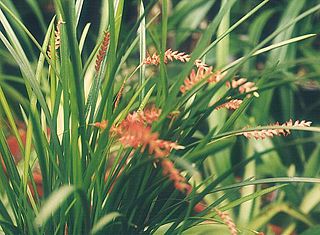
Dendrochilum is a genus of epiphytic, lithophytic and a few terrestrial flowering plants in the orchid family (Orchidaceae). The name of this genus is derived from Ancient Greek words dendron ("tree"), and either cheilos ("lip") or chilos, alluding to either the flowers' large lip or to their epiphytic growth. These orchids are popular among fans of non-traditional orchid curiosities.
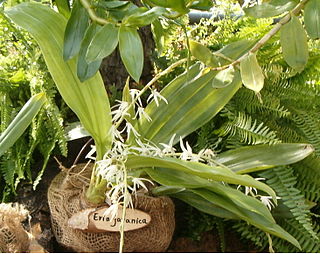
Eria is a genus of orchids with more than 50 species distributed in China, the Himalayas, the Indian Subcontinent, Southeast Asia, New Guinea, Polynesia, Melanesia and Micronesia.

Cylindrolobus is a genus of orchids with about 80 species that grow in New Guinea, Wallacea, Southeast Asia, southern China, and India.
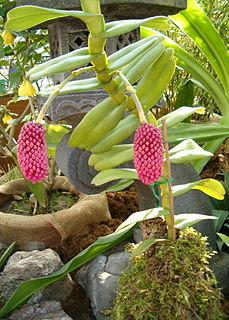
Robiquetia, commonly known as pouched orchids, or 寄树兰属 , is a genus of flowering plants from the orchid family, Orchidaceae. Plants in this genus are epiphytes with long, sometimes branched, fibrous stems, leathery leaves in two ranks and large numbers of small, densely crowded flowers on a pendulous flowering stem. There are about eighty species found from tropical and subtropical Asia to the Western Pacific.

Ascidieria is a genus of flowering plants from the orchid family, Orchidaceae. It is native to Thailand, Malaysia, Indonesia and the Philippines.
Dendrobium mindanaense, known as the Mindanao dendrobium, is an orchid species that is found on the Philippines. It was named for the island of Mindanao.
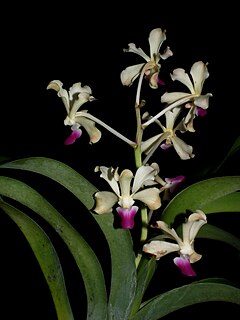
Vanda ustii, the University of Santo Tomas' vanda, is an orchid species found only in the Philippines. It is named after the University of Santo Tomas or U.S.T.
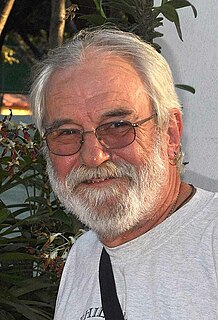
Jim Cootes For more than twenty-five years, he has been studying Philippine orchids, particularly in the wild, as an amateur Orchidologist in Mindoro, Philippines. He is a frequent lecturer and has written numerous articles for major orchid journals and magazines. He resides in Australia, where he works as a mail carrier.
Macropodanthus cootesii, known as Cootes' macropodanthus, is a species from the family Orchidaceae that is endemic to the Philippines. It is named after Australian Orchid Enthusiast Jim Cootes. Macropodanthus cootesii was only described in December 2010, by Dr. George Tiong, in the German journal Die Orchidee.
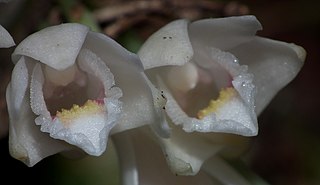
Dendrobium milaniae is flower of the Orchid family found in Leyte, Visayas in the Philippines, where it is found growing as an epiphyte above bodies of water at elevations up to 600 metres. The flower grows to approximately 1.5 centimetres (0.59 in). The plant is semi-pendulous and sympodial. Pseudobulbs are 10 cm by 2 cm; 3 to 6 green lanceolate leaves are present on the top third of the pseudobulb. Hans Fessel and Emil Lückel named this species in 1996 in Die Orchidee.

Dendrobium sanderae is a member of the family Orchidaceae endemic to the Philippines. It is found in the Montane Regions of Central Luzon, the Luzon tropical pine forests, north or the Philippines an epiphyte that grows on the trunks of pine trees in pine forest located at altitudes of about 1000 to 1600 meters. This epiphyte of medium size has erect, slightly thick below the middle pseudobulbs; racemes are short for dendrobiums and inflorescences are present during the dry season. Sepals and petals are white while the lip is white with a green or yellow center.
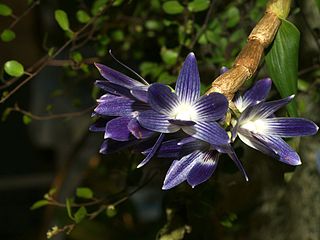
Dendrobium victoriae-reginae is a member of the family Orchidaceae endemic to the Philippines.
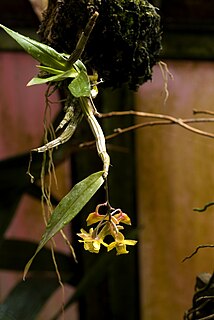
Dendrobium guerreroi, or Guerrero's dendrobium, is a member of the family Orchidaceae endemic to the Philippines. It was named in honor of Mr. Guerrero, a Filipino orchid collector in the 1900s. This species is a small to medium to large sized, warm growing epiphyte with thin descendant, clumping pseudobulbs that rarely branch and carry many, unsubdivided, pointed fleshy leaves. Flowers are 3 centimeters and are yellow with light orange labia.
Pinalia xanthocheila is a member of the family Orchidaceae.

Dendrobium boosii, or Ronny Boos' dendrobium, is a species of plant in the family Orchidaceae endemic to the Philippines.

Dendrobium bullenianum is a member of the family Orchidaceae found in the Philippines and Vietnam. It is named in honor of Mr. Bullen, orchid cultivator with Low & Co.'s nursery, who was first in Britain get this species to flower in cultivation. It is pendulous and sympodial with 1 meter long pseudobulbs of 1.5 cm thickness and deciduous leaves of 10 cm by 1.5 cm. Heinrich Gustav Reichenbach was the first to describe this species in 1862 in Botanische Zeitung. It is found as an epiphyte in elevations up to 1,000 metres in Luzon and Mindoro in the Philippines.
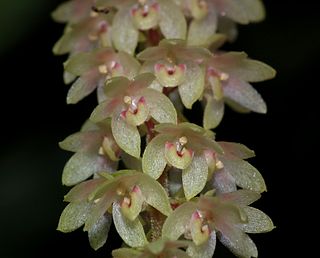
Pinalia polyura, or many-tailed pinalia, is a member of the orchid family endemic to the Philippines. It is semi-pendulous and sympodial, with pseudobulbs that are 20 cm long, 1 cm in diameter, and somewhat club shaped. Each new growth begins halfway along the previous year's pseudobulbs, making the plant longer each year. Each pseudobulb has about 5 shiny, lanceolate leaves approximately 15 cm long and 2 cm wide. Inflorescences appear at the upper portion of the plant and are pendulous, about 10 cm long and bear up to 40 flowers each 1.5 cm in diameter. It grows as an epiphyte and sometimes as a semi-terrestrial plant at elevations to 2,400 meters.

Vanda roeblingiana, Roebelen's vanda, is a species of orchid endemic to the mountain provinces of the island of Luzon in the Philippines. Hugh Low, a British colonial administrator and naturalist introduced the plant to London in 1893. The next year, Robert Allen Rolfe, an English botanist formally described the plant and thought it was originally collected from the vicinity of Singapore or Peninsular Malaysia. Low, who works in Clapton Nursery had collecting expedition to Southeast Asia with Singapore as headquarter.

Amesiella monticola is a miniature species of epiphytic orchid native to the Philippines. The specific epithet "monticola" refers to the montaneous habitat of the species. Monticola is a combination of "mons" or "montis", meaning mountain and "cola" or "colere" meaning "inhabitant" or "dweller". This species is critically endangered and its population is decreasing By some this species is treated as a mere variation of Amesiella philippinensis. Hence, it is synonymous with Amesiella philippinensis var. monticola These monopodial herbs form small, leathery leaves. The genus Amesiella forms white flowers with long spurs. These 1 to 6 very large flowers in relation to the vegetative parts of the plants are borne on short, axillary racemes. They have a characteristic long, twisted spur, indicating moth pollination. The flowers are purely white, devoid of any golden pigmentation of the labellum. This separates it from Amesiella philippinensis.
















